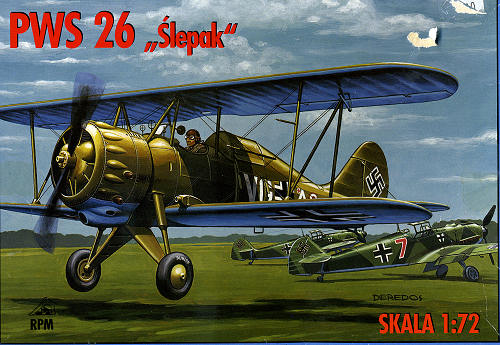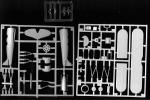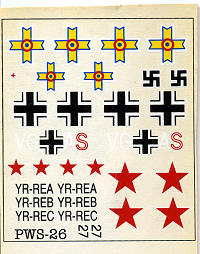
RPM 1/72 PWS 26 'Slepak'
| KIT: | RPM 1/72 PWS 26 'Slepak' |
| KIT #: | 72035 |
| PRICE: | I paid about $7.00 |
| DECALS: | Three options |
| REVIEWER: | Scott Van Aken |
| NOTES: |

| HISTORY |
The PWS-26 was a Polish advanced training aircraft, used from 1937 to 1939 by the Polish Air Force, constructed in the PWS (Podlaska Wytwórnia Samolotów - Podlasie Aircraft Factory). It was the second most numerous Polish pre-war aircraft, after the RWD-8.
The aircraft was a final development of a series: PWS-12, PWS-14 and PWS-16, designed in response to a Polish Air Force requirement for an advanced trainer. The chief designer was Augustyn Zdaniewski. The PWS-26 was a direct development of the PWS-16bis, sharing the same silhouette, being a more militarized variant - with strengthened construction, which allowed dive-bomber training. Contrary to its predecessors, the PWS-26 could be armed with a machinegun and practice bombs. It also had other improvements and was capable of aerobatics. A visual difference from the PWS-16bis were the canvas-covered struts of the landing gear.
The prototype was flown in 1935. After trials, its production started in 1936. By the outbreak of World War II in 1939, 320 had been built.
The PWS-26 was used in Polish military aviation from early 1937, becoming a standard type of advanced trainer for fighter pilots. It replaced most of the older PWS-14s, PWS-16s, PWS-18s (a license-built Avro Tutor) and Bartel BM-5d's. They carried numbers starting with "81-". The PWS-26 was regarded as a successful aircraft, with good flight characteristics. During its Polish service, there were 10 fatal crashes, which was not a high number.
After the German invasion of Poland, some PWS-26s were used in liaison flights, three aircraft in each, assigned to Armies (basic equipment of liaision flights was the RWD-8). The PWS-26 was mostly used as a replacement aircraft.
According to a report by Jan Falkowski, on September 3, 1939, while flying a PWS-26, he made a chasing Bf 109 crash near Lublin, by performing low-level maneuvers, but there was no confirmation from the Germans. A single PWS-26 and two RWD-8s of the Polesie Operational Group, were the last Polish aircraft in the sky during the campaign. Some Czech pilots flew these aircraft during the campaign on the Polish side.
Some PWS-26s were shot down by the Germans, at least one was shot down by the Soviets on September 19. A large number of PWS-26s were destroyed on the ground by the Germans or burned by the withdrawing Poles. A dozen or so were evacuated to Romania and at least 33 to Latvia. This latter group were captured by the Germans - in 1941. After some modification, 28 of them were sold to Romania. The Romanian aircraft (including those evacuated), entered service in civilian and military aviation (and used there until the 1950s). Two were tested in Germany. A dozen or so were captured by the Soviets in Poland and also used by them for testing.
| THE KIT |
 There
are two white sprues and one clear in the somewhat flimsy box that is typical of
RPM kits. Something of a throwback to the communist era. The parts are well
molded with a tiny bit of flash on some pieces and just a hint of mold
misalignment. Fabric detailing is fairly nice, though it does fall somewhat into
the 'hills and valleys' sort of thing on the upper wings. A nice engine is
provided that gets sandwiched into the five piece cowling. This will require a
bit of care in constructing. The interior is devoid of deta
There
are two white sprues and one clear in the somewhat flimsy box that is typical of
RPM kits. Something of a throwback to the communist era. The parts are well
molded with a tiny bit of flash on some pieces and just a hint of mold
misalignment. Fabric detailing is fairly nice, though it does fall somewhat into
the 'hills and valleys' sort of thing on the upper wings. A nice engine is
provided that gets sandwiched into the five piece cowling. This will require a
bit of care in constructing. The interior is devoid of deta il
and has two seats, two sticks and two instrument panels. The seats and sticks
fit on the raised area of the fuselage halves where the lower wings fit. There
are no positive locators for these items. Struts do have positive location holes
to help out with placement. There is basically one option, and that is to have
the aircraft as a single seat plane with a covered up rear seat as shown on the
box art. There is a fairing for this on the sprues and one would think that the
rear seat would not have to be used should this option be chosen.
il
and has two seats, two sticks and two instrument panels. The seats and sticks
fit on the raised area of the fuselage halves where the lower wings fit. There
are no positive locators for these items. Struts do have positive location holes
to help out with placement. There is basically one option, and that is to have
the aircraft as a single seat plane with a covered up rear seat as shown on the
box art. There is a fairing for this on the sprues and one would think that the
rear seat would not have to be used should this option be chosen.
Instructions are well done with new constructs shown as solid lines and ones done earlier as dotted lines. A nice way to do things. Color information is provided with Humbrol and Xtracolor references. No 'in work' color information is supplied. A rigging diagram is given showing which parts need to be rigged first. The decal sheet had become all rolled up in my example. It is printed with a single carrier and while the markings are crisply done, I'm not sure how good the sheet will be when it comes time to use it. There are three options. One is the single seat box art plane as used by the Luftwaffe. Another is a Russian plane, and the third is in Romanian markings. These latter two are twin seat planes. It seems like all are in a brownish green with a light blue underside to the wings and tailplanes.
| CONCLUSIONS |
A nice little kit of a plane that is not well known outside its home country. Of course, there is a Polish AF boxing of the plane, but this one of 'captured' versions should be nice to have as well.
| REFERENCES |
http://en.wikipedia.org
April 2008 Bought (on the cheap) for you so you can see
what it is like. If you would like your product reviewed fairly and quickly, please
contact
me or see other details in the
Note to
Contributors.